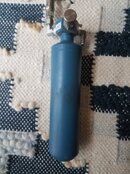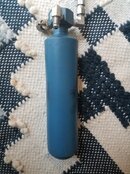Im guessing you have an old version of the SA-6 A or B
The SA-6B separator should look like the picture below right side.
This is the HP side working pressure 5000psig hydro test pressure 8000psig
The cap/plug has connected below a stainless mesh filter tube and a “spinner”
attached to the end to knock off the condensed water droplets into the tower below.
A manual bleed valve is connected to the base. Drain every 20 minutes,
The LP 2nd stage arrangement is very similar just different orientation of the fittings.
The electrical stop/start panel also shows a RESET button in blue, this will shut the compressor off every 25 minutes if you don’t reset it after manually draining the towers.
A mechanical drain with a friendly kill switch should you walk off and forget.
An alternative to the auto drains that are more expensive and have a habit of clogging up with ice.
You mentioned having separate separators, the second photo is the separate filter for the SA
[/URL]
Flow in the filter photo below is shown from left to right
1. Using the same JIC 4 inlet inlet and outlet connection
2. Inlet non return valve (so you can bleed down the separators and not disrupt the chemical filter retained stable pressure )
3. Inlet inline bleed valve (so you can bleed the filter of and any water condensate carry over once a day and after each fill cycle to extend chemical filter life)
4. Filter tower including stainless re pack chemical zeolite cartridge or throw away cartridge
5. Visual indicator (indicates blue dry, pink when wet in a 10/20/30% relitive humidity band
6. Back Presure regulator (set 1500 psi) with non return valve on the discharge side (to stop full scuba clinders back filling the chemical tower at sonic speed velocities and disrupting the tamped down chemical when the compressor is off)
7. Outlet pressure gauge (also acts to indicate scuba cylinder pressure when attached before starting or filling)
8. Outlet filling whips (1 or 2) using same JIC4 connection can also be fitted directly to the compressor bypassing the filter tower for compressor performance and leak testing.
[/URL]








